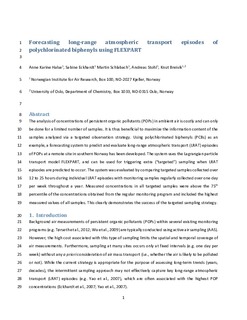Forecasting long-range atmospheric transport episodes of polychlorinated biphenyls using FLEXPART
Journal article, Peer reviewed
Accepted version
Permanent lenke
http://hdl.handle.net/11250/2469009Utgivelsesdato
2013Metadata
Vis full innførselSamlinger
- Publikasjoner fra Cristin - NILU [1329]
- Vitenskapelige publikasjoner [1068]
Originalversjon
Halse, A.K., Eckhardt, S., Schlabach, M., Stohl, A., Breivik, K. (2013). Forecasting long-range atmospheric transport episodes of polychlorinated biphenyls using FLEXPART. Atmospheric Environment, 71, 335-339. doi:10.1016/j.atmosenv.2013.02.022 10.1016/j.atmosenv.2013.02.022Sammendrag
The analysis of concentrations of persistent organic pollutants (POPs) in ambient air is costly and can only be done for a limited number of samples. It is thus beneficial to maximize the information content of the samples analyzed via a targeted observation strategy. Using polychlorinated biphenyls (PCBs) as an example, a forecasting system to predict and evaluate long-range atmospheric transport (LRAT) episodes of POPs at a remote site in southern Norway has been developed. The system uses the Lagrangian particle transport model FLEXPART, and can be used for triggering extra (“targeted”) sampling when LRAT episodes are predicted to occur. The system was evaluated by comparing targeted samples collected over 12-25 h during individual LRAT episodes with monitoring samples regularly collected over one day per week throughout a year. Measured concentrations in all targeted samples were above the 75th percentile of the concentrations obtained from the regular monitoring program and included the highest measured values of all samples. This clearly demonstrates the success of the targeted sampling strategy.

